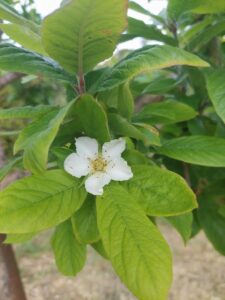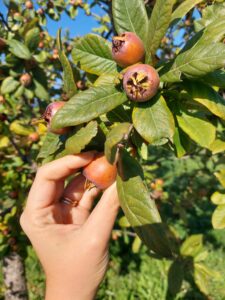THE MEDLAR TREE
In local dialect “Nespolo d’inverno”
Mespilus germanica L.
Rosaceae
According to recent studies, the medlar tree (Mespilus germanica L.) is native to the Caucasus region, but it also spread to Iran, Turkey and Greece.
Today, it can be found throughout Europe where it grows spontaneously in woodlands. It is highly resistant to winter cold, and it grows up to one thousand meters. The Romans facilitated its spread, and it became so popular that in Germany, when Linnaeus was about to classify it, he named it Mespilus Germanica, suspecting that this tree was native to that region. The medlar is an accessory fruit resulting from the swelling of the tissue around the true fruits.
.

🌳 The Forgotten yet Resistant Tree
The medlar has been cultivated since Roman times and the Middle Ages, but today it has almost disappeared from modern gardens.
It is highly resistant to cold and drought, and it adapts to poor soils. Because of this, it is considered a real “tough guy” in nature.
🐝An Ally for Biodiversity
It blooms in late spring, avoiding late frosts and providing nectar for bees when other plants have already bloomed. Additionally, birds love its winter berries, making it an excellent tree for wildlife.
🍈The Fruit Eaten… Rotten!
Freshly harvested medlars are hard and astringent, so they need to overripen until they become soft, brown and doughy. They may seem rotten, but it is the perfect time to taste them!
For this ripening process, they are left in the open air or in boxes with straw. This is an ancient method also used for persimmons and service tree fruits.
🍯 A Unique and Surprising Taste
Once ripe, the medlars have a sweet taste, with hints of dried figs, dates and baked apples. It ripens over the winter, and because of this, it is one of the few sweet winter fruits.


📜 A Noble and Literary Story
It was a fruit appreciated at medieval feasts because, in winter, it provided sweetness when little fresh fruit was available.
It is also mentioned by Shakespeare and Geoffrey Chaucer in their works, often in reference to its “un-noble” appearance and the slightly spicy double meaning associated with its shape.
For example, in “Romeo and Juliet,” Mercutio jokes about the shape of the fruit and its name, which in English sounds similar to “meddler” (a nosy person) and also had sexual connotations:
“Now will he sit under a medlar tree,
And wish his mistress were that kind of fruit
As maids call medlars, when they laugh alone.
O Romeo, that she were, O that she were
An open-arse, thou a poperin pear!”
(Romeo e Giulietta, Atto 2, Scena 1)
🔹 – Medlar was often used obscenely in Elizabethan England, as the ripe fruits open up and take on an evocative shape.
🔹 – Poperin pear refers to a variety of long, narrow pear, with an erotic double meaning, often translated into Italian as “zucchina” (zucchini) for the more explicit sexual reference.
This passage is an example of Mercutio’s typical obscene humour, mocking Romeo and his idealized romanticism.
Even Geoffrey Chaucer, the famous author of The Canterbury Tales, makes reference to the medlar with an allusion to the fact that the fruit becomes good only when it is fully ripe. In The Reeve’s Tale, he says:
“And yet, God woot, that it is routhe to see
A young man be so old in looks, and tho
He may be likened to a medlar, tho
That never yet was ripe until it rot.”
(The Reeve’s Tale, vv. 3863-3866)
🔹Chaucer uses the medlar (nespola) as a metaphor for a person who does not reach full maturity until they are in a state of decay.
🔹This reflects a common theme in medieval literature, where the medlar symbolizes aging, decay, or late maturity.
The reason for these allusions is that:
The fruit, when unripe, is hard and inedible, but once it ripens, it becomes brown, soft, and doughy, evoking bodily and sexual imagery.
The word “medlar” already had vulgar connotations in the language of the time, making it perfect for wordplay in theatrical and poetic texts.
The medlar was a common fruit in the Middle Ages and the Renaissance, so the audience was well acquainted with the ironic references. Today, however, we may bump into these literary staples without understanding their meaning, due to the loss of biodiversity and knowledge of nature.
These contents were written and researched by the owners of the SiGi Agricultural Company in collaboration with the students of the Agricultural Technical Institute of Macerata.
If you would like to contribute to expanding the descriptions of these varieties, you can send an e-mail to info@agricolasigi.it
We launched the e-museum of ancient fruits thanks to a social farming project of the Marche region. The translation is by komalingua
This project enabled five young people with cognitive impairments, aged 20 to 25, to work on the farm. They were selected by psychologists and Anffas social workers, supported by the professional educator Il Faro and supervised by UniMc researchers. Coldiretti Marche handled communication and distribution.
This unique and challenging project led to the creation of both a physical and virtual museum of ancient fruits in SiGi’s garden. This is not only a great honor but also a significant commitment that we are willing to continue with everyone’s support. You can contribute to our projects by choosing our products, or you can do so directly here:

